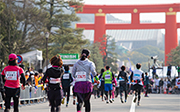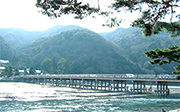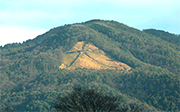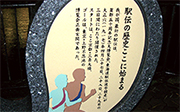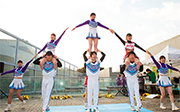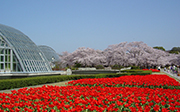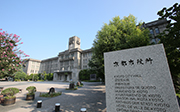About the Course
The Kyoto Marathon 2015 course takes runners on a fascinating journey through the "City of International Culture and Tourism." Runners will pass through seven UNESCO World Cultural Heritage sites and many other tourist attractions as they are treated to spectacular views of Kyoto's scenery, including all five mountains where huge bonfires are lit during the Gozan no Okuribi summer festival. Adding charm to this annual event staged in an urban setting, a portion of the course will meander through scenic downtown Kyoto.
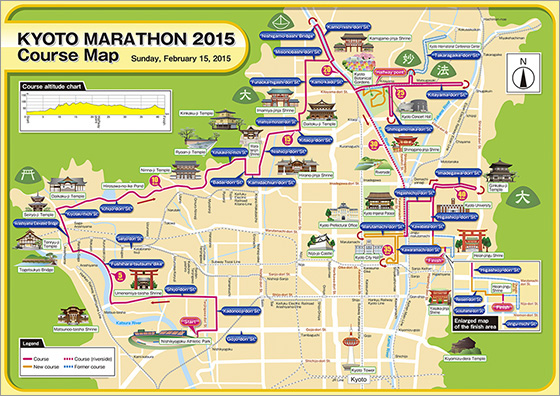
Running the course while enjoying the attractions that only Kyoto can offer!
Attraction #1:Kyoto – City of International Culture and Tourism
Located along the course are the seven UNESCO World Cultural Heritage sites of Tenryu-ji Temple, Ninna-ji Temple, Ryoan-ji Temple, Kinkaku-ji Temple, Kamigamo-jinja Shrine, Shimogamo-jinja Shrine, and Ginkaku-ji Temple, as well as many other tourist attractions including Umenomiya-taisha Shrine, Matsunoo-taisha Shrine, Seiryo-ji Temple, Daikaku-ji Temple, Hirano-jinja Shrine, Wara-tenjin Shrine, Daitoku-ji Temple, Imamiya-jinja Shrine, and Heian-jingu Shrine. Other landmarks on the course include amazing works of architecture such as Kyoto Concert Hall and Kyoto City Hall.
Attraction #2:Kyoto – City of "Beautiful Scenery"
Runners follow a course along the Katsura River with a view of Togetsukyo Bridge in Arashiyama, and then pass through the picturesque Sagano area and Hirosawa-no-ike Pond. The course then leads to Kinukake-no-michi Road, which has been famous for its scenic beauty for over 1,000 years, passes through the Kyoto Botanical Gardens, extends along the Kamo River, a symbol of Kyoto, and then takes the runners on a trip through history in the verdant Kyoto Gyoen National Garden. Yet another major thrill of the Kyoto Marathon is the view of the five mountains that are the focus of the Gozan no Okuribi festival. During the festival, huge bonfires are lit on the mountains to form the Chinese characters "大" (meaning "large" or "great") and "妙法" (meaning "Buddha's teachings") and two familiar shapes (a torii shrine gate and a boat).
Attraction #3:Kyoto – City of Universities
A total of ten universities can be found along the course. Many students add to the excitement of the race not only as participants, but also as volunteers and members of groups who encourage runners along the course.
Attraction #4:Kyoto – City of Road Races
Kyoto is the birthplace of the ekiden long-distance relay race. The race starts at Nishikyogoku Athletic Park – known for the All-Japan High School Ekiden Championship and the Empress's Cup – Inter-Prefectural Women's Ekiden – and continues along main streets in the ancient capital, such as Nishioji-dori Street, Higashioji-dori Street, and Marutamachi-dori Street.
Features of the New Course
1. Setting of the downtown rout
A part of the new course now follows two of Kyoto's busiest downtown streets - Marutamachi-dori Street and Kawaramachi-dori Street. The sight of urban landmarks, such as Kyoto Imperial Palace and Kyoto City Hall Square, will greet the runners along the way.
2. Setting of the Kyoto Botanical Gardens route
In keeping with the main concept – "DO YOU KYOTO? Marathon – An Event in an Environmentally Advanced City" – the new course follows a route through the Kyoto Botanical Gardens, a symbolic venue of culture and eco-friendliness in Kyoto.
3. Abolition of the Kitsunezaka Hill route (Kitsunezaka Hill - Kyoto International Conference Center)
Kitsunezaka Hill on Takaragaike-dori Street involves a long stretch of steep ascents and descents that many say put too much of a burden on runners in the latter half of the course, which already includes many ups and downs. In order to encourage participation from a broader range of runners, this portion of the course has been abolished.
4. Change of the route before the finish line
The route from Higashiyama-Marutamachi to the finish line has been changed to one that does not include a turn.


